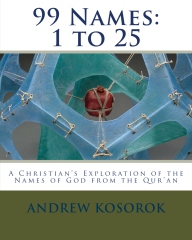As a sculptor, I’m very familiar with the phrase, “Sculpture is what you back into while looking at a painting.” In the Western art world there is an unspoken hierarchy of value given to media used in art production, with painting–particularly figurative painting–consistently remaining at the top. The last two thousand years of Western societies have marked histories in relation to, or reaction against, iterations of Christian messages, and this ongoing relationship informs how we view art. The Body of Christ, John explains, is the miraculous Embodiment of God’s Word, and it appears to make sense that our culture values things associated with that major impact on Western societies. All references to bodies on some level can be taken as a symbol of the Body of Christ; if this is true, of course figurative painting would consistently remain among the most highly valued.
In Islam, the Word was given to Mohamed through the instrument of Gabriel, and written as Mohamed in turn recited it to his wife and other followers. The language used to communicate in the Divine Presence is far beyond our capacity to comprehend, an Imam in Holland explained to me, and Arabic is the closest human language can come to that Divine mode of communication. Although Mohamed never learned to read and write, he was adept at memorizing; Gabriel would pronounce the passages of the Qur’an, command Mohamed to listen, memorize, and repeat back what he spoke, then Mohamed would share the revelations with others, many of whom wrote what they heard; Mohamed’s wife Khadija, a truly remarkable woman, was one of the principle scribes during this period. One of the miracles of the Qur’an, an Imam from Egypt explained to me, is that when years after Mohamed’s passing all the manuscripts were compared, the writings of those who wrote the revelations were identical.
In Islamic tradition the ability to record and transmit knowledge is a truly Divine gift; before Mohamed Arabic culture depended largely on verbal transmission. Even though Mohamed himself remained illiterate, one of his profound legacies is the vital importance attached to writing itself–and among all the languages, the tongue of revelation (or Tongue of Angels, Arabic) is the most profound. Very quickly after the revelation of the Qur’an everything symbolizing that sacred work became revered, particularly Arabic calligraphy. Even the act of writing and its associated tools were wondrous things. Dr. Nassar Mansour of WISE University in Jordan told me that even the ink used had several layers of symbolism–it was made from the soot of mosque lamps, so the words meant to illuminate the path of the spiritual journey were themselves created from the lights used to illuminate the path itself.
I overheard a comment by an art teacher that he was saddened Islamic arts haven’t flourished in our contemporary environment, and I’m happy to say he was misinformed. Several friends who have offered words of encouragement and instruction on the 99 Names Project are calligraphers of significant renown including scholars, teachers, and participants in international biennials of the Arab Spring. My friend Rick Sasulka’s website is particularly fun–he’s taken the time to show how we can participate in the centuries-old tradition of Arabic calligraphy. Here are just a few links:
Arabic Calligraphy, Galleries of Arabic Calligraphy
Islamic Arts and Architecture, David James’ “Calligraphy–the geometry of the spirit”
Islamic Arts Magazine, a Survey of International Islamic Arts
ArtBismallah, Learning Islamic Calligraphy by Rick Sasulka
ArtHafeez.com, Artwork of Hafeez Shaikh
eL Seed, an Amazing Calligraffiti Artist
Oweis, Website of Dr. Fayeq Oweis, Calligrapher and Teacher, and his article on the tools of the Calligrapher
The Pen and Inkpot, Work by Architect, Calligrapher and Teacher Uzma Mirza
Peter Gould Design, Excellent Contemporary Muslim Design
Sakkal Design, Artwork of Mamoun Sakkal, and some excellent history of The Art of Arabic Calligraphy
Zakariya Calligraphy, Artwork of Mohamed Zakariya, and his article on the History and Development of Islamic Calligraphy
As Western art reveres the human form, it being by association a symbol of the Word “made flesh” to dwell among us, so Islamic art reveres calligraphy above all other media, because of its associations with the Word made legible that we might read it every day. Christians seek to hold within them a semblance of the Divine countenance, and Muslims seek to have the Qur’an written on their hearts. St. Augustine taught that each of us carry the indelible imprint of something within which gives evidence of our Divine Creator, and urges us to reach towards Him; although he referred to this as the Potter’s mark on our souls, ink and paint both do nicely.



